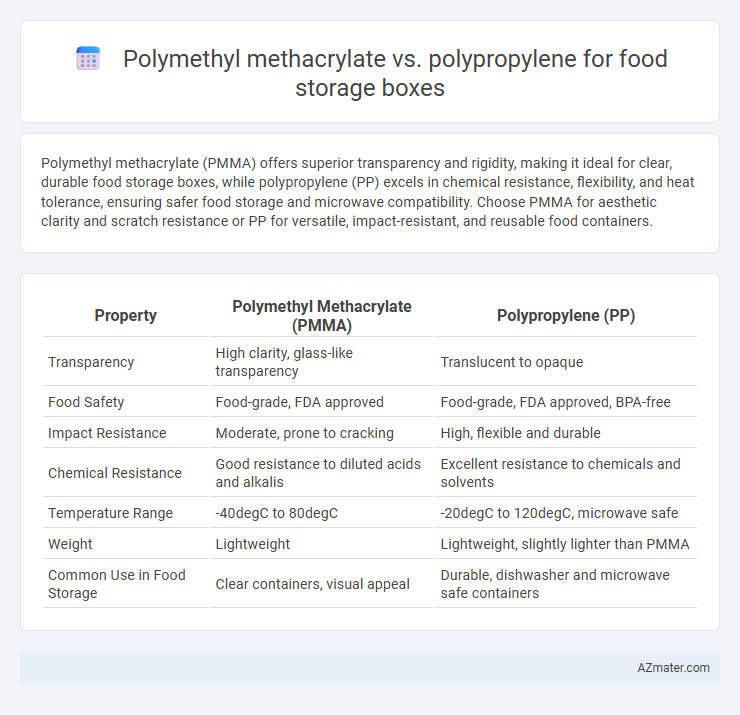Polymethyl methacrylate (PMMA) offers superior transparency and rigidity, making it ideal for clear, durable food storage boxes, while polypropylene (PP) excels in chemical resistance, flexibility, and heat tolerance, ensuring safer food storage and microwave compatibility. Choose PMMA for aesthetic clarity and scratch resistance or PP for versatile, impact-resistant, and reusable food containers.
Table of Comparison
| Property | Polymethyl Methacrylate (PMMA) | Polypropylene (PP) |
|---|---|---|
| Transparency | High clarity, glass-like transparency | Translucent to opaque |
| Food Safety | Food-grade, FDA approved | Food-grade, FDA approved, BPA-free |
| Impact Resistance | Moderate, prone to cracking | High, flexible and durable |
| Chemical Resistance | Good resistance to diluted acids and alkalis | Excellent resistance to chemicals and solvents |
| Temperature Range | -40degC to 80degC | -20degC to 120degC, microwave safe |
| Weight | Lightweight | Lightweight, slightly lighter than PMMA |
| Common Use in Food Storage | Clear containers, visual appeal | Durable, dishwasher and microwave safe containers |
Introduction to Food Storage Materials
Polymethyl methacrylate (PMMA) and polypropylene (PP) are widely used materials in food storage boxes due to their durability and safety. PMMA offers excellent clarity and resistance to UV light, making it ideal for transparent containers, while polypropylene provides superior chemical resistance and flexibility, ensuring durability under varying temperatures. Both materials comply with food safety regulations, but polypropylene is often preferred for microwave and dishwasher use because of its heat tolerance.
Overview of Polymethyl Methacrylate (PMMA)
Polymethyl methacrylate (PMMA) is a transparent thermoplastic commonly used for food storage boxes due to its excellent clarity and high resistance to impact and UV light. Its non-toxic and odorless properties make it safe for direct food contact, while its rigidity and resistance to staining provide durability and ease of cleaning. Unlike polypropylene, PMMA offers superior transparency, making it ideal for applications requiring clear visibility of stored food items.
Overview of Polypropylene (PP)
Polypropylene (PP) is a lightweight, durable thermoplastic commonly used in food storage boxes due to its excellent chemical resistance and high heat tolerance, typically up to 100degC. Its low moisture absorption and strong impact resistance make it ideal for maintaining food freshness and preventing breakage during daily use. Polypropylene is also BPA-free and microwave-safe, meeting safety standards for food contact materials.
Material Safety for Food Contact
Polymethyl methacrylate (PMMA) offers excellent clarity and is FDA-approved for food contact, ensuring non-toxicity and resistance to food-staining substances. Polypropylene (PP) is widely used in food storage due to its high chemical resistance, heat tolerance up to 100degC, and compliance with FDA and EU food safety regulations. Both materials are BPA-free and suitable for food contact, but polypropylene's superior thermal properties and durability make it more versatile for microwave and dishwasher use.
Durability and Impact Resistance
Polymethyl methacrylate (PMMA) offers excellent clarity and moderate impact resistance, making it ideal for visually appealing food storage boxes but less suitable for heavy impact applications. Polypropylene (PP) boasts superior durability and high impact resistance, ensuring long-lasting performance and resistance to cracking or breaking during daily kitchen use. PP's flexibility and toughness make it a preferred choice for food storage containers requiring resilience under frequent handling and temperature variations.
Temperature Tolerance and Stability
Polymethyl methacrylate (PMMA) offers superior temperature tolerance for food storage boxes, withstanding heat up to 80degC without deformation, making it suitable for hot food applications. Polypropylene (PP) exhibits excellent thermal stability, tolerating temperatures from -20degC to 120degC, allowing safe use in both freezer and microwave environments. PP's chemical resistance and impact strength provide enhanced durability, while PMMA delivers clarity and rigidity but with lower heat resistance compared to PP.
Transparency and Aesthetic Appeal
Polymethyl methacrylate (PMMA) offers superior transparency with light transmittance up to 92%, making it ideal for food storage boxes where clear visibility of contents is essential. Polypropylene (PP) typically has a more opaque appearance and lower clarity, which can limit its aesthetic appeal for showcasing food. The high gloss finish and excellent color retention of PMMA enhance the overall visual appeal compared to the matte surface often found in polypropylene containers.
Ease of Cleaning and Maintenance
Polymethyl methacrylate (PMMA) offers a smooth, non-porous surface that resists staining and odors, making it easier to clean with just mild soap and water, ensuring low maintenance. Polypropylene (PP) is also highly resistant to stains and odors, but its slightly textured surface can trap food residues, requiring more thorough cleaning efforts. Both materials are dishwasher-safe, but PMMA's clarity and hard surface tend to maintain a pristine appearance longer under regular use.
Environmental Impact and Recycling
Polymethyl methacrylate (PMMA) offers clarity and durability but poses environmental challenges due to its lower recyclability and longer degradation period compared to polypropylene (PP). Polypropylene is widely recycled and has a smaller carbon footprint, making it a more sustainable choice for food storage applications. Its ease of processing and higher recyclability rate contribute significantly to reducing landfill waste and environmental pollution.
Cost Comparison for Food Storage Boxes
Polymethyl methacrylate (PMMA) food storage boxes generally incur higher costs due to their superior clarity, rigidity, and scratch resistance compared to polypropylene (PP) containers, which are more affordable but less transparent. Polypropylene offers excellent chemical resistance and flexibility at a lower price point, making it a popular choice for budget-conscious consumers seeking durable yet economical food storage solutions. In terms of cost efficiency, polypropylene food storage boxes provide a more economical option while polymethyl methacrylate containers cater to premium markets requiring aesthetic appeal and sturdiness.

Infographic: Polymethyl methacrylate vs Polypropylene for Food Storage Box
 azmater.com
azmater.com